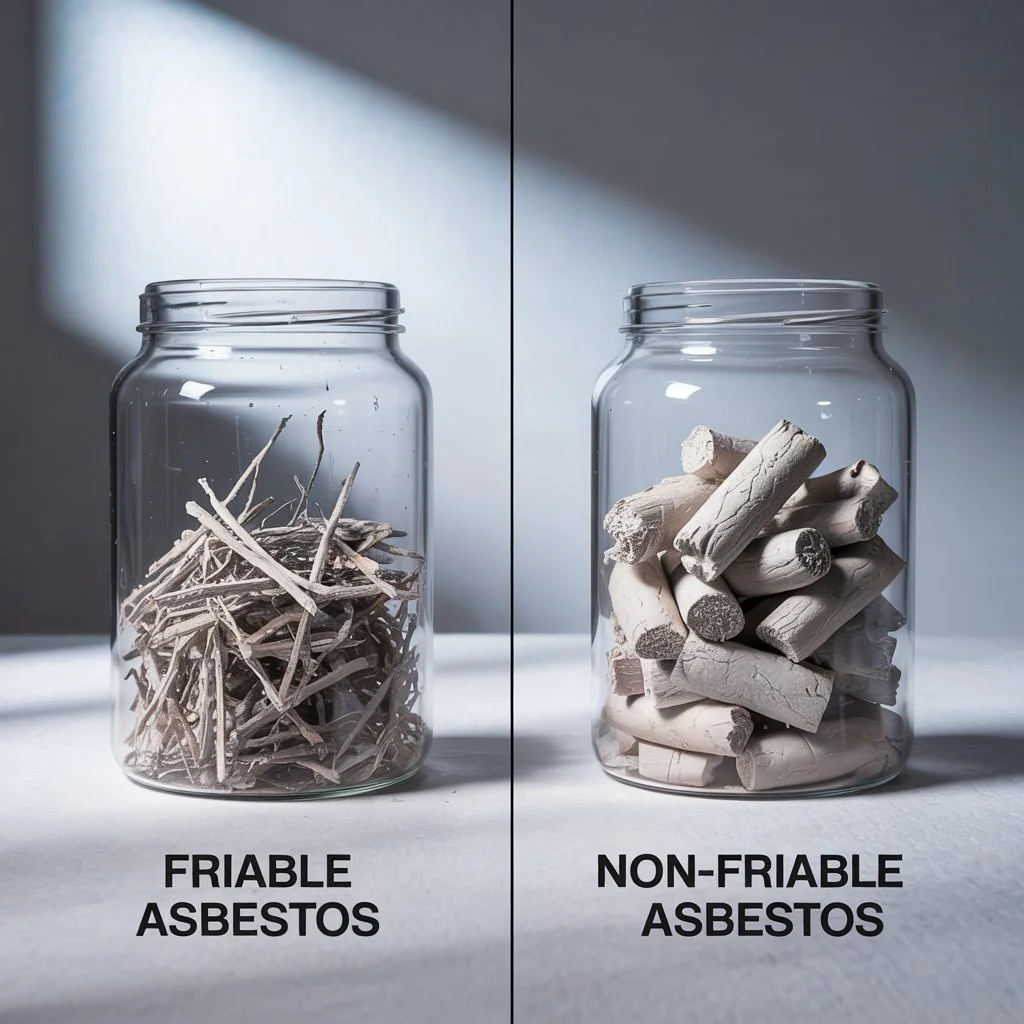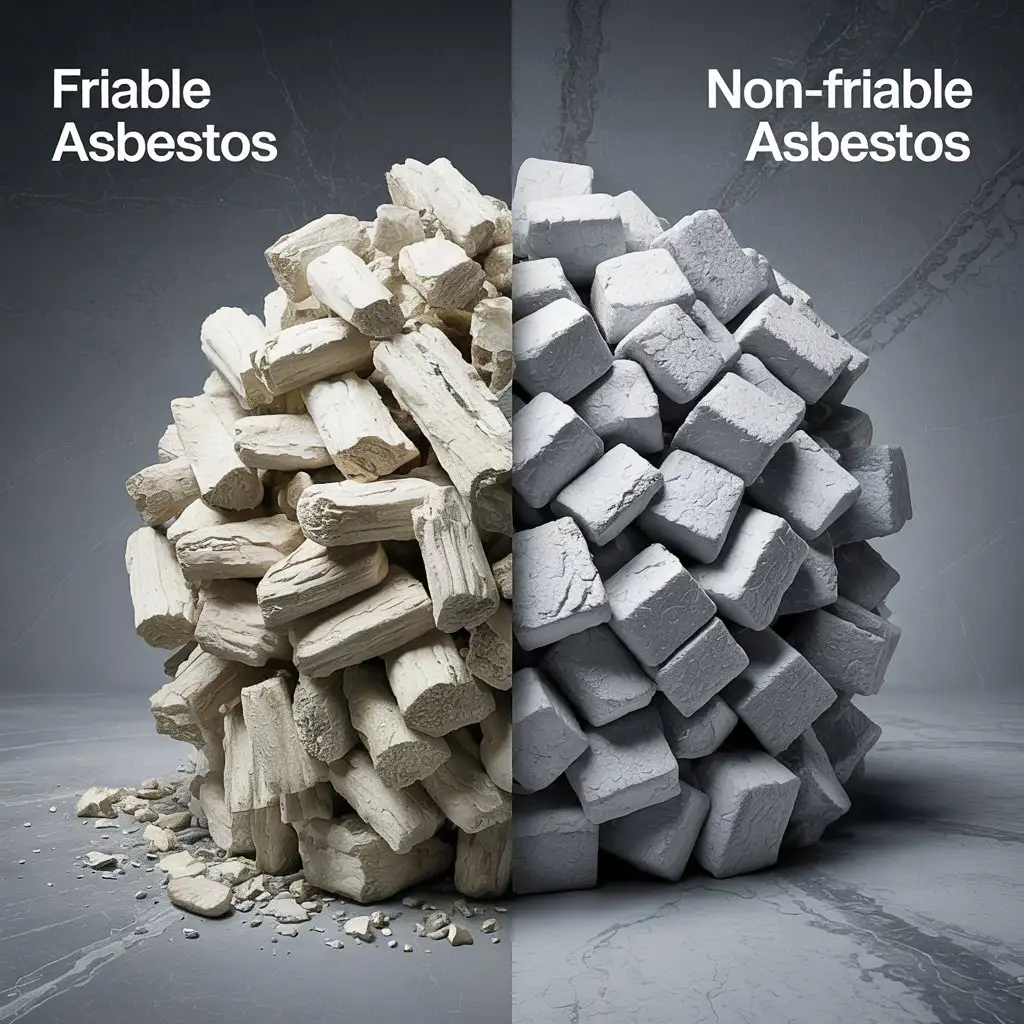Asbestos is a hazardous mineral that was once widely used in a variety of industries due to its heat resistance, durability, and insulating properties. However, exposure to asbestos can lead to serious health issues, including lung cancer, asbestosis, and mesothelioma. Understanding the different types of asbestos both by their mineral structure and friable vs. non-friable classification is essential for proper handling and safety measures.
This article will explore the mineral structure of asbestos (Serpentine vs Amphibole), as well as the classification of asbestos based on whether it is friable or non-friable. Each type of asbestos presents different levels of risk, and knowing how to identify them is crucial for health and safety.
What is Asbestos?
Asbestos is a naturally occurring mineral that has been used for its ability to withstand high temperatures, resist corrosion, and provide insulation. There are several types of asbestos, and they are often categorized based on their mineral structure and whether the asbestos is friable or non-friable. Understanding these categories is essential for assessing the potential risks associated with exposure to asbestos.
Asbestos Based on Mineral Structure: Serpentine vs Amphibole

Asbestos fibers are divided into two primary groups based on their mineral structure: Serpentine and Amphibole. These two categories have different physical properties, and their potential for releasing harmful fibers into the air varies significantly.
Serpentine Asbestos
Serpentine asbestos is characterized by curly, flexible fibers. The most common type of serpentine asbestos is chrysotile, also known as white asbestos. Chrysotile is by far the most widely used form of asbestos, and it was often incorporated into various construction materials, including insulation, roofing, and floor tiles.
Properties of Serpentine Asbestos:
- Curly and flexible fibers: The fibers are less likely to break into smaller particles compared to amphibole asbestos.
- Common in building materials: It was widely used in insulation, tiles, brake linings, and cement.
- Easier to process: The flexible nature of serpentine fibers made it easier to manipulate and incorporate into materials.
Health Risks of Serpentine Asbestos:
While serpentine asbestos, particularly chrysotile, is considered less brittle than amphibole asbestos, it still presents serious health risks when disturbed. Exposure to chrysotile fibers can lead to:
- Lung cancer
- Mesothelioma (a cancer affecting the lining of the lungs)
- Asbestosis (a chronic lung disease)
Amphibole Asbestos
Amphibole asbestos consists of straight, needle-like fibers. The amphibole group includes several types of asbestos, each with different properties. These types of asbestos are generally more hazardous than serpentine asbestos due to their sharp, brittle fibers, which are more likely to break into smaller, inhalable particles when disturbed.
The five main types of amphibole asbestos are:
- Amosite (Brown Asbestos)
- Crocidolite (Blue Asbestos)
- Anthophyllite Asbestos
- Tremolite Asbestos
- Actinolite Asbestos
Properties of Amphibole Asbestos:
- Straight, needle-like fibers: These fibers are more brittle and prone to breaking, making them more dangerous when disturbed.
- Higher health risks: Because the fibers are smaller and sharper, they can more easily become airborne and lodge in the lungs.
- Common in industrial applications: Amosite and crocidolite were widely used in industrial insulation, cement, and pipe coverings.
Health Risks of Amphibole Asbestos:
Amphibole asbestos poses a greater health risk than serpentine asbestos because of the straight, needle-like fibers that can penetrate deep into the lungs. Prolonged exposure can lead to:
- Mesothelioma
- Lung cancer
- Asbestosis
Friable vs Non-Friable Asbestos

Asbestos-containing materials (ACMs) can be classified as friable or non-friable, based on their condition and how easily they release asbestos fibers into the air. This classification is important because it determines the level of risk and the necessary safety precautions.
Friable Asbestos
Friable asbestos refers to materials that are easily crumbled, broken, or pulverized by hand pressure. When friable asbestos is disturbed, it can release asbestos fibers into the air, posing a significant health risk.
Characteristics of Friable Asbestos:
- Easily broken down: Friable materials can be easily disturbed and break apart, releasing harmful asbestos fibers.
- Common in insulation: Friable asbestos is often found in insulation materials, sprayed coatings, and ceiling tiles.
- High potential for exposure: Due to the ease with which these materials break apart, they present the highest risk for releasing fibers.
Health Risks of Friable Asbestos:
When friable asbestos is disturbed, it can release microscopic asbestos fibers into the air. These fibers can be inhaled, leading to severe respiratory diseases such as:
- Lung cancer
- Mesothelioma
- Asbestosis
Friable asbestos is considered extremely hazardous and requires specialized training and equipment for removal.
Non-Friable Asbestos
Non-friable asbestos refers to materials that are more durable and less likely to release asbestos fibers into the air under normal conditions. These materials are typically bound with other substances, such as cement or vinyl, which makes them more resistant to breaking apart.
Characteristics of Non-Friable Asbestos:
- Durable and resistant to damage: Non-friable asbestos is less likely to release fibers unless it is physically damaged (e.g., cut, sanded, or broken).
- Common in building materials: Non-friable asbestos is often found in products like asbestos cement (used in roofing, siding, and pipes), floor tiles, and shingles.
- Lower risk under normal conditions: Non-friable asbestos materials are less likely to release fibers unless they are disturbed.
Health Risks of Non-Friable Asbestos:
Non-friable asbestos presents a lower risk of fiber release but can still be hazardous if disturbed or damaged. If these materials are damaged during demolition or renovation, asbestos fibers may be released, leading to similar health risks as friable asbestos, including:
- Lung cancer
- Mesothelioma
- Asbestosis
Key Differences Between Serpentine vs Amphibole and Friable vs Non-Friable Asbestos
| Aspect | Serpentine Asbestos | Amphibole Asbestos |
|---|---|---|
| Mineral Structure | Curly, flexible fibers (e.g., Chrysotile) | Straight, needle-like fibers (e.g., Amosite, Crocidolite) |
| Flexibility | Flexible | Brittle and sharp |
| Commonly Used | Insulation, flooring, roofing materials | Industrial insulation, cement products, pipe covering |
| Health Risks | Lung cancer, mesothelioma, asbestosis | Higher risk for mesothelioma, lung cancer, and asbestosis |
| Classification | Friable Asbestos | Non-Friable Asbestos |
| Physical Properties | Easily crumbled and broken | Resistant to breaking unless disturbed |
| Fiber Release | High risk of fiber release | Low risk under normal conditions |
| Common Materials | Insulation, fireproofing materials, ceiling tiles | Roofing, floor tiles, cement products |
| Health Risks | High risk for lung cancer, mesothelioma, asbestosis | Lower risk, but still hazardous if disturbed |
Conclusion
Understanding the types of asbestos based on their mineral structure and friable vs non-friable classification is crucial for managing the risks associated with asbestos exposure. Friable asbestos, due to its ability to easily release fibers into the air, poses the highest health risks, while non-friable asbestos is generally safer unless it is disturbed.
The mineral structure of asbestos also plays a significant role in determining the material’s properties and associated risks. Serpentine asbestos, including chrysotile, is more flexible, whereas amphibole asbestos types, such as amosite and crocidolite, are more brittle and dangerous when disturbed.
If you suspect that asbestos is present in your environment, it is essential to follow proper safety procedures and consult with licensed professionals for safe asbestos removal and disposal. Understanding the different types of asbestos and how to handle them is key to minimizing exposure and ensuring a safe environment.
Contact Us For more Info
Email: [email protected]
Phone Number: +937 252-4724
Address: 2617 S Smithville Rd, Dayton, Oh, United States

Dr. Chris Cameron is a leading asbestos expert with over two decades of experience in occupational and environmental health. He holds a Ph.D. in Environmental Science and has worked extensively with government agencies, private sector organizations, and health and safety regulators to assess, manage, and mitigate asbestos-related risks. Dr. Cameron is widely recognized for his research on asbestos exposure, remediation strategies, and public health policy